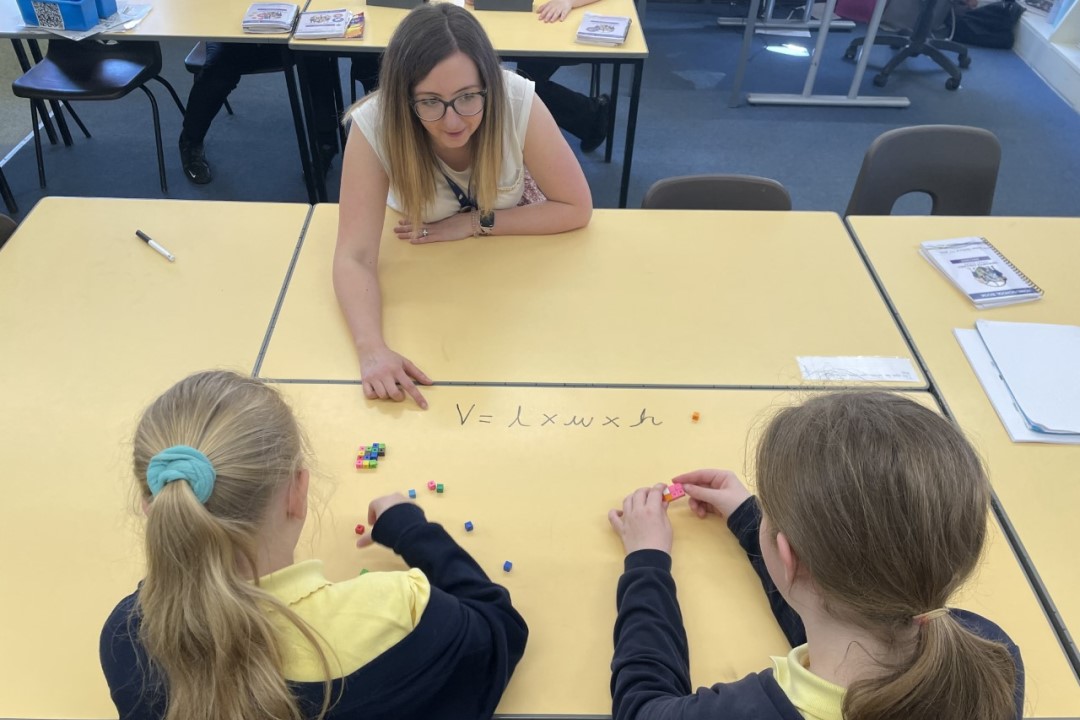- Published: 10/05/2023
When a school makes the decision to engage with their local Maths Hub, in a bid to move towards a mastery approach, it can be motivated by very different reasons. In this feature we look at the journeys taken by two very different schools, in two very different areas, who have both engaged with their local Maths Hub. Despite their different contexts, both schools have seen a positive impact for their pupils.
Usworth Colliery Primary School
Usworth Colliery Primary School sits in the middle of an estate in Tyne and Wear in the north-east of England. The two-form entry was built for the children of miners, and many of its families are living in some of the most deprived neighbourhoods in the country. It has high levels of Pupil Premium and FSM, and a significant number of children with complex emotional and behavioural needs.
In this challenging context, everything leaders do must have a focus on supporting children to make better than expected progress, so a drive to improve maths provision and support children to achieve were the main factors in the school’s decision to adopt a mastery approach. They turned to Great North Maths Hub for support, as Victoria Moore, the school’s maths lead, explains:
“Individual teachers started to engage with some of the teaching for mastery CPD offered by Great North Maths Hub and we all just really, really loved it. And the more we did, the more we realised that we weren’t really on a proper mastery trajectory. We used the word ‘mastery’, but we weren’t really there.”
So, in 2017, the school engaged with the Mastery Readiness Programme, which aims to look at school systems and prepare for the start of the teaching for mastery journey. Starting the mastery journey with Readiness is ideal for schools that may operate in a more challenging context, to get the school into a good position to take on mastery. Next was Development, which focuses on the mastery pedagogy of the two lead teachers from the school. Then came the Embedding programme, which aims to spread the mastery approach throughout the school and allows a focus on next steps. Schools then move to Sustaining, a rolling programme of support to ensure a teaching for mastery approach is really ’business as usual’ and finely tuned. Victoria explains how the Sustaining programme has enabled Usworth Colliery to create a real culture of teaching for mastery in which all staff are on board:
“Sustaining is such a good programme because other teachers in the school can get involved, as well as the maths lead. And they’re not always people who are experienced or interested in maths. Every teacher who engages with the hub comes back to school with greater confidence and understanding.”
Victoria is similarly enthusiastic about the improvements in children’s attainment, and reports that the use of small, progressive steps and pre-teaching have led to a significant reduction in post-lesson intervention. She notes that children are kept together, there are no gaps in their understanding, and they all feel like they can achieve.
“Data doesn’t always tell you the full story. I had one child who would cry during maths lessons and felt real anxiety. She’s now working securely at the expected standard and approaches maths with a real confidence. The mastery approach – representations, a slower pace and stem sentences – unlocked maths for her. It made it make sense.”
 St Thérèse of Lisieux RC Primary School
St Thérèse of Lisieux RC Primary School
St Thérèse of Lisieux RC Primary sits on the border of North Yorkshire and the Tees Valley and, like Usworth Colliery, has progressed through the Teaching for Mastery Programme and is now engaged in the Sustaining programme. However, its context is very different. A single-form entry in a leafy suburb, only 3% of its children receive FSM, and it has very low levels of children with SEND.
St Thérèse’s had always enjoyed excellent results in KS1 and KS2 assessments and had been successfully using a traditional spiral scheme, where topics are covered more quickly, in less depth, and revisited more frequently. As school leaders were encouraged to look towards teaching for mastery, they faced a dilemma: their existing approach seemed to work well and there was no pressing reason for change.
Maths lead, Caroline Hunter, reached out to Archimedes Maths Hub in a bid to find out more, and the more she learned about teaching for mastery, the more confident she was that this was the direction the school should take.
When asked what it was that convinced her to put aside their existing scheme and embrace teaching for mastery, Caroline explains:
“It was the philosophy. Our KS2 SATs results were extremely good but were we creating mathematicians? I don’t think we were. I’m so passionate about maths and I wanted the children in our school to feel that. I wanted them to feel the excitement. I wanted them to love maths.”
 The changes in pupils at St Thérèse’s were gradual but profound:
The changes in pupils at St Thérèse’s were gradual but profound:
“We started to see children able to use their prior learning, and the concepts that they have learned in different year groups and different topics, and apply that to a new problem. We saw them starting to make links and really starting to think like mathematicians.”
It's safe to say that all staff at St Thérèse’s are now firmly on board and, like at Usworth Colliery, different teachers engage with the Maths Hub each year to help build a sustainable and embedded culture of teaching for mastery.
Find out more
Whether you are looking to embark upon a mastery journey or get your school back on track, your local Maths Hub can help. Fully-funded maths CPD is available to all primary schools across England.

